|
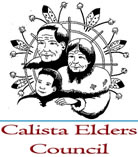 570 3rd Ave # 219 570 3rd Ave # 219
Bethel, AK 99559
(907) 543-1541
 625 C Street
Anchorage, AK 99501 625 C Street
Anchorage, AK 99501
(907)929-9200
anchoragemuseum.org
|
|
 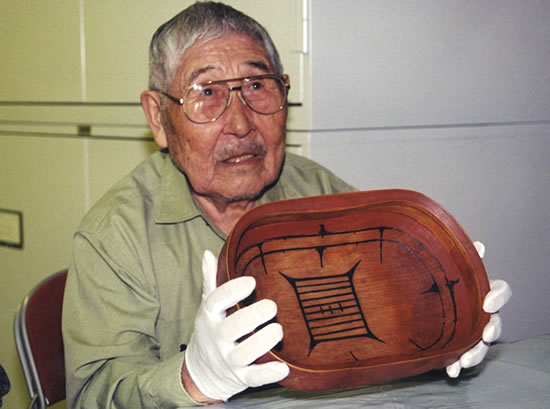
|
AFR |
Frank Andrew examines a bowl at the Smithsonian Museum Support Center, 2003. The painted square probably represents strips of gut sewn together to make a seal-gut window. |
 |
Una wani qantaq qaneryarai amllertut. Tamaani una qantaq una qanruyuteklaraat. Pitengnaqlermun ataluni qantaq una.
Neqkaq tamarmi tailuni qantamtenun eklerkaa pitekluku umyuarteqlallruukut atu'urqamteggu qantaq una. Kaigatnguluni tua-i una waten neqkaarmek neryullermek piciatun imangqerresqumaluku; imirluku nerqiurluta wangkuta.
There are many teachings associated with this bowl. Back in those days they taught us things about the bowl and how to use it. The bowl was directly connected to hunting. When we used the bowl, we thought about the food that would be placed inside it in the future. We'd ask that it be filled with food that we wanted to eat; we'd continue to fill it and feed others.
--Alex Bird, Emmonak |
Every day women brought carefully crafted bowls of food to their husbands and sons in the qasgi, and their presentation often had special significance. A young woman serving a young man a bowl of food could signify that they were now married.
Bowl bottoms were often decorated with a three-toed design, representing the footprint of the creator-bird Raven. Men painted bowl interiors with their own inherited family designs. |
Qantat Bowls
 |
|
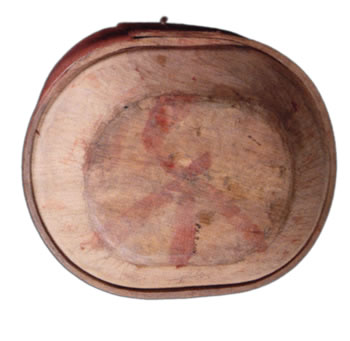
|
Bowls were stored upside down on a corner shelf, so these three-toed Raven's foot designs would have been among the first things one saw when entering the house.
Frank Andrew said: "They could not go without making this line design on bowl bottoms, and many people used it."
|
Anchorage Museum, Gift of the Huffmon Family 2002.025.298; Gift of Fred and Sara Machetanz 1985.035.210 and 1985.035.204
|
| |
Tumnaq Serving Bowl

|
Tumnaq/Serving bowl Alex Bird noted: "This was used when they fed people in the qasgi and had a feast." K. Fuller, Alaska State Museum IIA5678 |
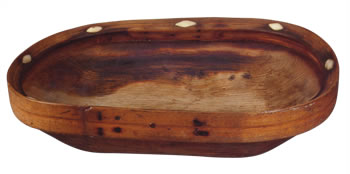 |
|
Yupiit Piciryarait Cultural Center and Museum 80.6.1 |
Angucetaq Qantaq Man's Bowl
 |
|
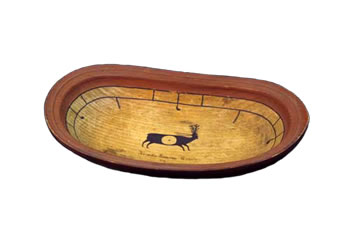
|
Man's bowl made from a single piece of wood, with painted caribou design belonging to his family. S. Jackson, 1890s, Kuskokwim, Sheldon Jackson Museum IIS073
|
Gift of Alma E. Lahnum and Williard W. Lahnum, Anchorage Museum 1998.025.003 |
| |
Arnartaq Qantaq Woman's Bowl

|
Woman's bowl made with a detachable bottom and separate upper rim. Peter John exclaimed, "This bowl is so nice and well made! It is for a woman and has her design inside. Only women's bowls have upper parts like this. A skilled person really worked carefully on this." |
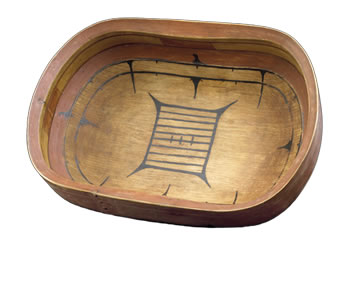 |
|
E. W. Nelson, 1879, Big Lake, Department of Anthropology, Smithsonian Institution 38340 |
Qantacuaraak Two Small Bowls
 |
|
.jpg)
|
Two small bowls from Nelson Island with underside decorations, one a man's smiling face and the other a woman's face with downturned mouth.
|
I. A. Lee, 1910, Peabody Essex Museum 13076, 13077 |
| |
Uqurvik Qantaq Seal-oil Container

|
Seal-oil container from the mouth of the Kuskokwim. Paul John said, "Those coastal people use seal oil with every meal with frozen food and especially with dried food." |
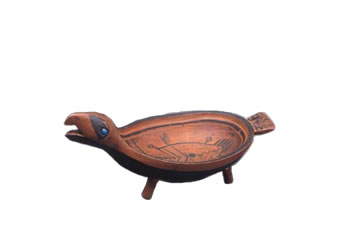 |
|
G. B. Gordon, 1905, University of Pennsylvania Museum of Archaeology and Anthropology NA689 |
Ilutuliar Deep Bowl
 |
|
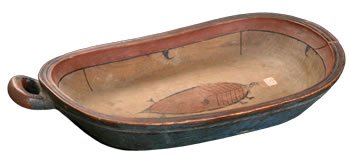
|
Deep bowl used by Moravian missionary Edith Kilbuck as a bathtub for her children during their years in Bethel in the 1890s.
|
Gift of the Kilbuck Family--Katherine, Elizabeth, John, Margaret, Helen, and Edith, Anchorage Museum 2004.059.001 |
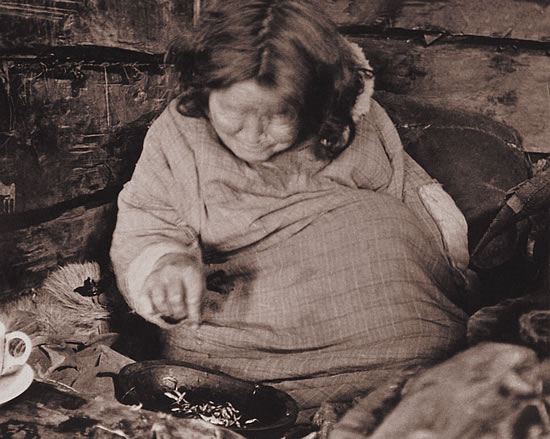
|
Martin Family Collection, 1931, Anchorage Museum B07.5-A15 |
An elderly woman eats needlefish from a wooden bowl. |
 |
Makut maani angutet qantait imumi kencikluki pitullrulliniit. Cali-llu qantaq waten unatni paluita tegungaunaku. Tua-i-ggur-am waten paluita tegukuniu, pitarkaa-gguq paluruciiqaa.
In the past women cared for men's bowls with utmost respect. And when a woman picked up a man's bowl, she was not allowed to take it with her palms down. If a woman picked up a man's bowl in this manner, it was said that the man's future catch was being covered.
--Annie Blue, Togiak |
 |
Qantaqa qanruyuteka aturluku nererraarlua painricuitellruaqa.
Tua-llu pilaraitkut, qantarput-gguq una neqem tamarmi tumyaraqaa. Pairpek'naku-gguq pegcunaituq.
Following my instructions, I always licked my bowl after I ate. They told us that our bowl was the pathway for all foods that come to us. We were told not to leave it without licking it.
--Frank Andrew, Kwigillingok |
Next
|
|

